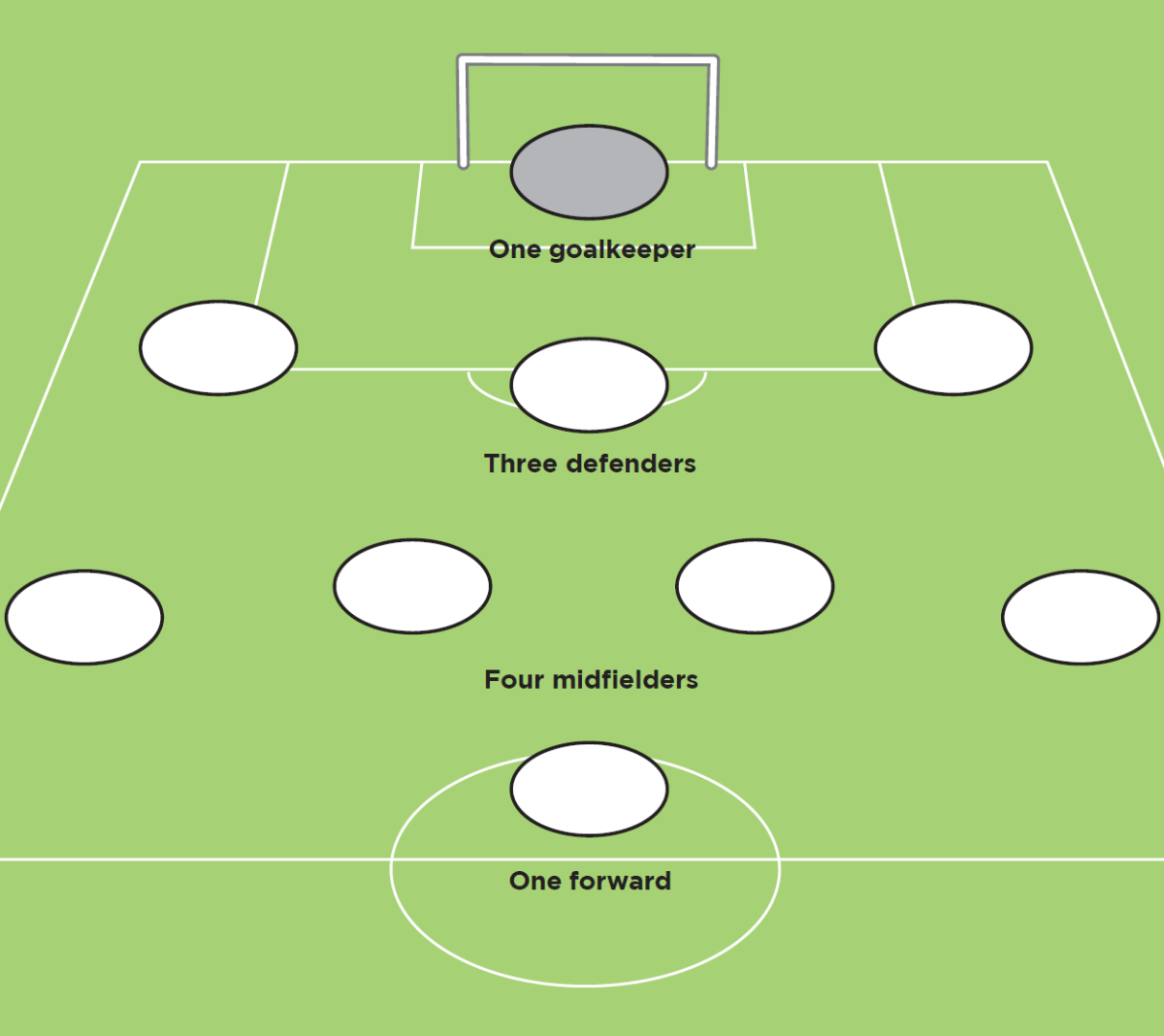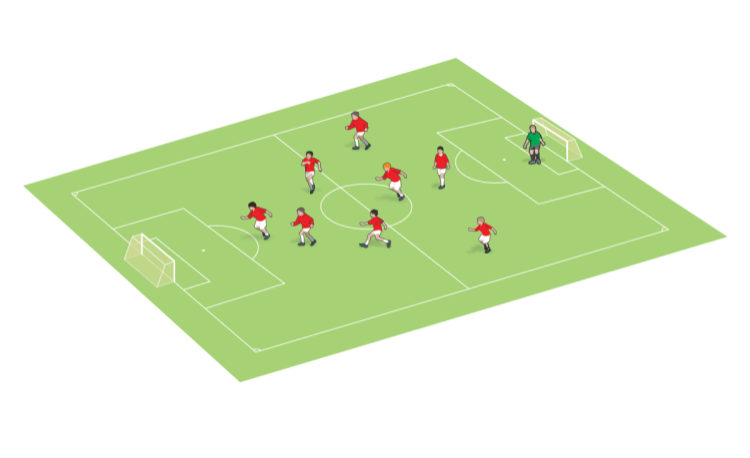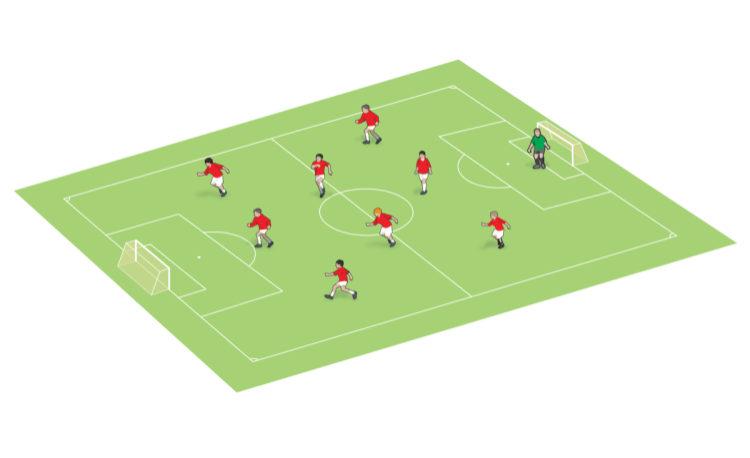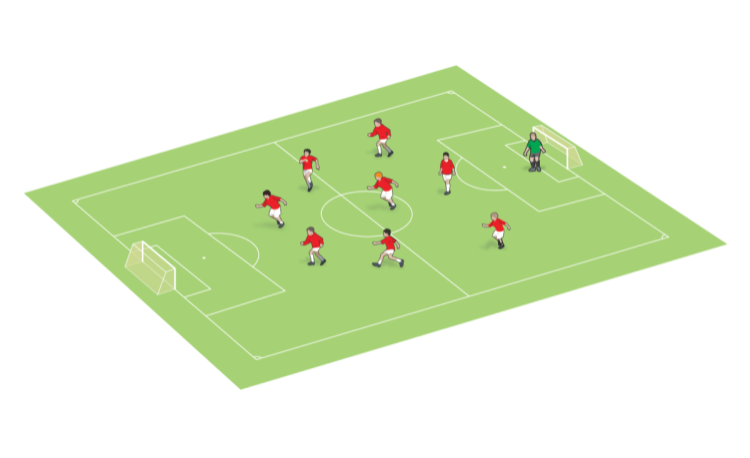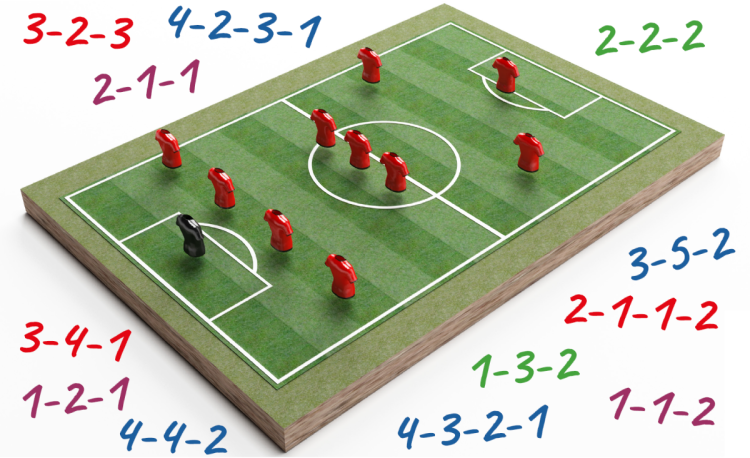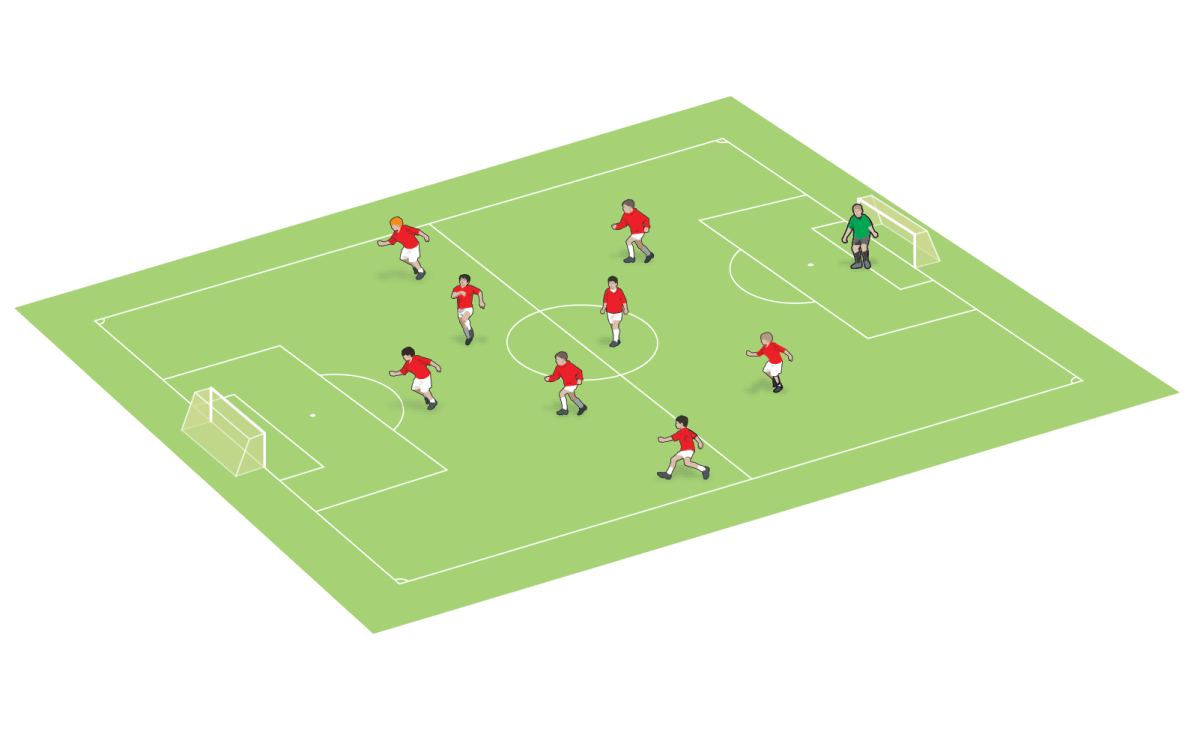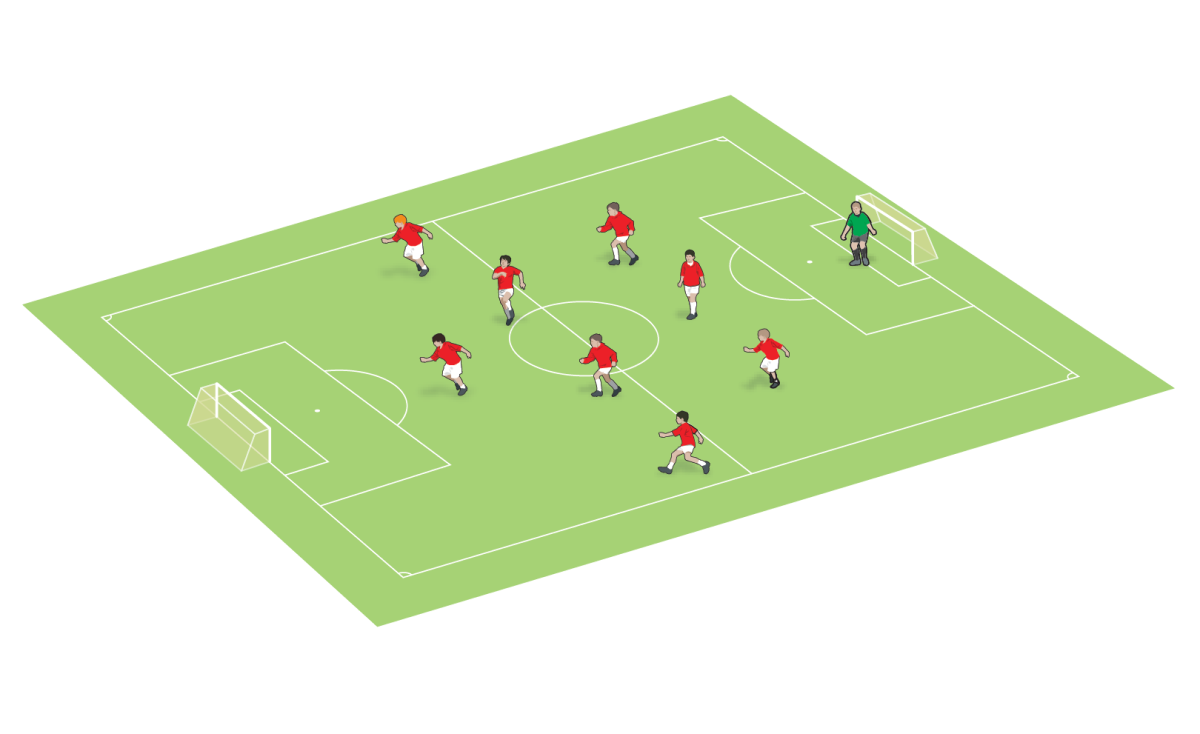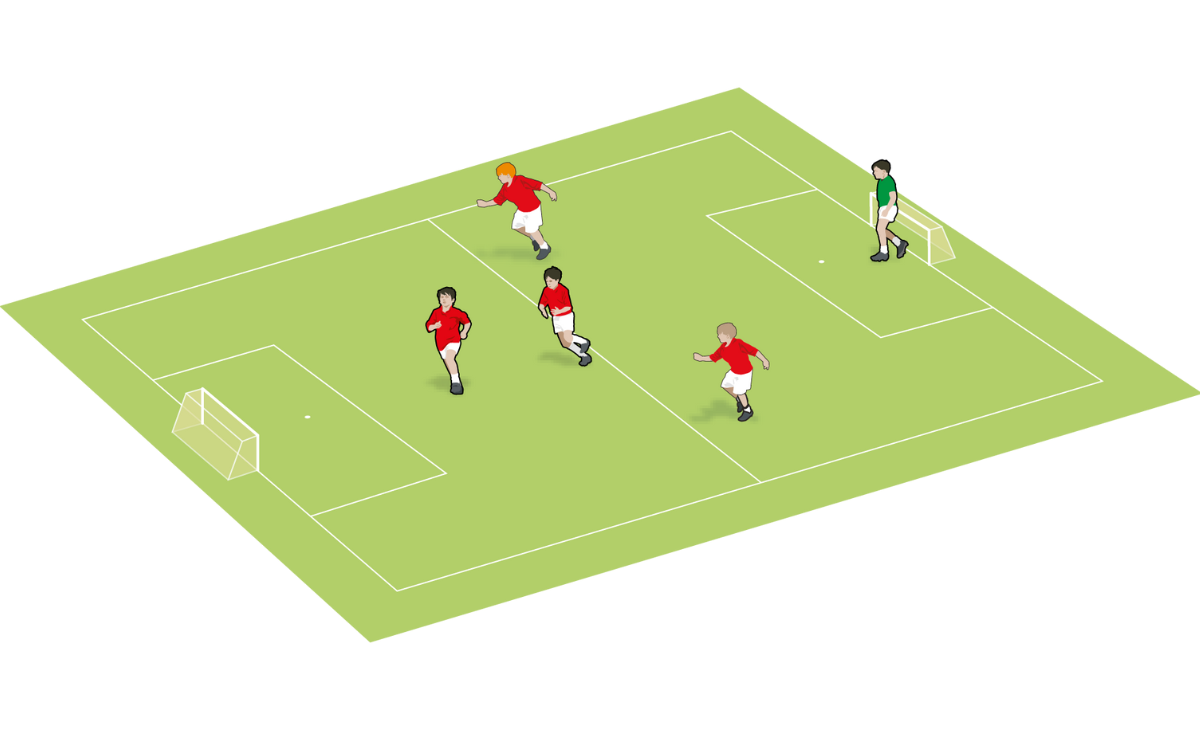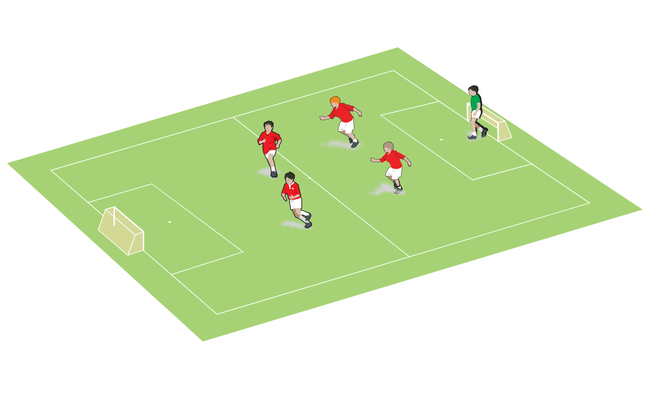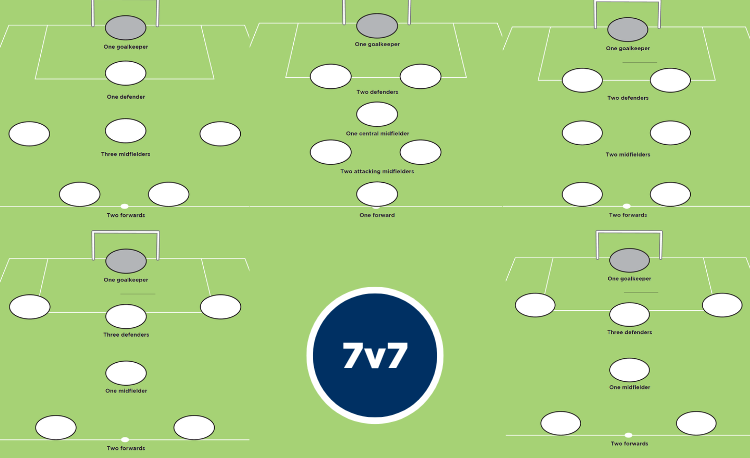9-a-side formation: 3-4-1
Why choose this 9v9 formation? Review the pros and cons, in possession and out of possession principles, and each position
Progresses from: 2-3-1 (7-a-side)
Progresses to: 4-5-1 (11-a-side)
PROS OF THIS FORMATION |
CONS OF THIS FORMATION |
|
|
|
|
|
|
9v9 3-4-1 - IN-POSSESSION SUMMARY
IN-POSSESSION PROS |
IN-POSSESSION CONS |
|
|
|
|
|
|
|
|
|
3-4-1 IN-POSSESSION - BY POSITION
Goalkeeper
Extra players across the defensive and midfield units will encourage the players to build up patiently. It is therefore likely the goalkeeper will play an integral part in this.
To take full advantage of the additional players, the ball should be switched from one side of the pitch to the other. The goalkeeper will quite often be involved in this process.
To do this, the keeper needs to constantly readjust their position to be in the right place to receive the ball from a team-mate who is under pressure and looking for the safe option of playing the ball back.
Some key details are crucial, such as ensuring the passing line for the ball to travel along is clear and, where possible, being positioned to the side of the goal rather than inside of the posts – because any mis-control could result in the ball going into the goal.
As well as being in the correct position, the goalkeeper will also need to be able to control the ball effectively so that it can be switched to the other side of the field quickly. This will allow the space available to be exploited before it disappears.
A goalkeeper receiving on the back foot and pushing the ball out of their feet, towards the player they want to pass it to, should allow the whole action to be completed in two touches.
Though this would appear to be a simple action, the need for it to be carried out flawlessly every time while under pressure is a real challenge and only time and practice will help a goalkeeper to perfect it.
Central defender
The central defender plays a key role in this formation when the team has the ball.
By stepping up the field, between the two central midfielders and the two wide defenders, they essentially move from being a central defender into a holding midfielder.
In this position, they will look to link the play between the defensive and midfield units. A key attribute for this is high levels of awareness – they must know what is around them, ahead of them and behind them.
They will also need to work on their support play and positioning. Despite playing in the central position, they will need to operate across the full width of the pitch when the team is in possession. This is particularly important when the ball progresses to the midfield unit.
In any team, it is sometimes difficult for the midfielders to play forward passes because the further up the pitch you progress, the smaller amount of space is available.
Therefore, to retain possession, midfielders will often look to play backwards to a team-mate in a suitable position behind them.
In this formation, this team-mate will mostly be the central defender who has moved into the midfield role. They will need to adjust their position, moving across the pitch as the ball is transferred from one side to the other.
Related Files
- Wide players ensure the team has width and help to create penetration going forward
- The forward will often need to keep hold of the ball until support arrives
- Wider defenders have lots of passing options and must select the correct one
- Central midfielders stay high and central to provide support to the forward
- Goalkeeper must constantly readjust their position to be in the right place to receive the ball from a team-mate
- Central defender steps up to link the play between the defensive and midfield units
Wide defenders
When receiving the ball in this formation, wide defenders should have a number of passing options available to them: the wide players, the central defender, the central midfielders and the goalkeeper.
The key to this position, when in possession, is in selecting the correct pass. Doing so will help the team progress forward quickly, and get the ball away from the dangerous areas of the pitch.
If they select the wrong pass, it can delay the team’s progress up the field, which will give the opposition more opportunities to win the ball close to our goal.
Worse still, the wrong pass could result in giving the ball away directly, putting the team in a really difficult and dangerous situation.
A further part of this pass-selection process is identifying where, specifically, the player receiving the ball wants to receive it.
It is likely that most players will be marked closely by an opponent. Therefore, even an accurate pass into them can result in them losing possession.
To prevent this, the player passing the ball needs to identify where exactly their team-mate wants to receive it so that they can retain possession and complete their next action quickly and efficiently.
"Combining with a team-mate allows the wide player to progress up field..."
For instance, if a player is under pressure from an opponent who is approaching from their right side, the ball could be played to the left side.
This will then allow the player to turn away from their opponent while protecting the ball by getting between the ball and the opponent.
Wide players
As this formation encourages a number of players to play in central areas, the wide players are crucial in ensuring the team has width.
They also need to ensure they are constantly available for a pass to allow the team to get the ball away from busy central areas when required. This could also be in the form of a switch of play.
Once a wide player has received the ball, they have a number of different opportunities available to them – more so than if they were in a similar position in seven-a-side, or even in other nine-a-side formations.
These options allow the player to deliver one of the key in-possession principles: penetration.
Combining with a team-mate, like playing a one-two, allows the wide player to progress up field and get beyond an opponent.
By staying in a wide position, it is likely that they will not be closely marked as they receive the ball, but will then come under pressure quickly from an opponent looking to close down their space.
There is therefore an opportunity to exploit this movement of the opposition player by shifting the ball back inside from where they came from.
As the pass is played inside, it is natural for this defender to watch the ball, giving the wide player a chance to run off the back of them and collect the return pass.
To do this effectively, it is important that the wide player plays the pass into their team-mate with accuracy and the correct amount of weight.
Then, once they have done this, they recognise the right moment to move to receive the returned pass.
Central midfielders
With the central defender stepping into midfield, and the wide players providing the team with width, the two central midfielders need to ensure they stay high and central.
Their main role is to provide support to the striker, who will become isolated without it.
To do this effectively, they will need to understand where exactly the striker needs the support and be proactive, rather than reactive, in their play.
In terms of where to support the striker, the players can look for simple indicators, such as, when they are in possession of the ball, which way are they facing?
If the striker is facing forwards, for example, they will want support ahead of them. If they have their back to goal, they will want to play the ball backwards to the support players.
The central midfielders must ensure this support is provided quickly, as the striker will only be able to retain possession for a short period of time. They therefore need to ensure that they are always in a position where they are able to provide support when required.
However, the midfielders also need to go beyond this. They must try and predict what will happen next, especially as there is two of them.
For example, although the striker may have their back to goal and require a team-mate to be in a position to receive a backwards pass, it only takes one player to do this. The other central midfielder must identify that, when the ball is played back, their midfield colleague will be facing forward and will want to play the ball in that direction.
The two central midfielders need to be able to work together so that they do not take up the same positions and provide the same option as their partner.
"Central midfielders must ensure support to the forward is provided quickly..."
Forward
Being quite isolated means the lone forward will quite often have to keep hold of the ball until support arrives.
Because the offside rule applies at nine-a-side, the forward will often have a defender positioned behind them when they receive the ball.
Therefore, one of the ways to retain the ball is by shielding it from their opponent. But, because of the nature of the seven-a-side format, it is unlikely that a forward would have had many opportunities to develop this part of their game.
When learning how to shield the ball, they will not only need to develop their technique but also their physical side, as well.
To protect the ball effectively, a lone forward needs to be strong enough to hold off the defender and prevent them from reaching it.
Another thing the striker needs to consider is making sure they are always in a position to receive the ball from a team-mate who is looking to play a forward pass.
Because they are the only player in the forward unit, they will be the only option in terms of getting the ball into advanced areas quickly. This is made more difficult by the pitch being much wider in this format of the game, compared to seven-a-side.
Therefore, if the ball is switched from one side of the pitch to the other, the forward needs to move across the pitch as well.
They must be mindful that they do not move into an area of the pitch where they are occupying space that a team-mate wants to go into, especially the player who is in possession of the ball.
Not only will they need to recognise the importance of moving across the pitch, but they also need to identify when to make a forward run to either receive the ball or to create space for a team-mate.
9v9 3-4-1 - OUT-OF-POSSESSION SUMMARY
OUT-OF-POSSESSION PROS |
OUT-OF-POSSESSION CONS |
|
|
|
|
3-4-1 OUT-OF-POSSESSION - BY POSITION
Goalkeeper
The main areas of the pitch the opposition will look to exploit when playing against this formation are the wide areas, especially during moments of transition.
As the two wide players are needed to help the team produce width when attacking, it is likely that in certain moments during the game they will be caught out in high areas of the pitch, so it should be anticipated that the opposition will look to exploit these spaces.
Because the nine a-side pitch is a lot bigger than the one used in seven-a-side, players will look to cross the ball when they are in a wide area as they are a lot further away from the goal.
This means that the goalkeeper will likely have to deal with crosses more often, compared to when they play in other formations.
The type of crosses they will face will probably be varied, as opposition players – who are also adjusting to the larger pitch – get used to crossing the ball from these greater distances.
This will provide them with an opportunity to work on their ability to be able to catch and punch a ball that is above their heads, something they would not have done too much when playing seven a-side.
Central defender
Given that, in possession, the central defender has been asked to move forward slightly into more of a midfield role, their first requirement out-of-possession is to remember to drop back into position once the team has lost the ball.
They then take on the role of being the most aggressive of the three defenders, meaning they are the one who attacks the ball when played into their part of the field.
To do this, they need to develop an ability to read the game, or predict what is going to happen. This allows them to defend on the front foot and be more proactive in their defending, rather than reactive.
The change in format, and the additional rules associated with it, brings with it some additional responsibilities for some players.
It is important that the central defender takes control of where the back line is positioned. They are the focal point for the other two defenders when they are working out where they should be stood.
By being in the correct position, they can help ensure that no-one in the team plays an opponent onside.
Because the pitch is now much bigger, it is important the team remains compact to limit the space available to their opponents.
One way in which to do this is to close the space between the different units. The central defender needs to recognise when the space between the defensive and midfield units is too large and move forward to close the gap.
All these actions require leadership skills and good communication, which the player can develop while playing in this position.
- Wide players must make strong recovery runs when team loses the ball
- Forward must be disciplined and not just chase the ball – setting them a task can be helpful
- Central midfielders’ job is to provide the three defenders with protection
- Central defender is ’aggressive’ first defender, engaging the player in possession,
- Because the opposition will try to exploit space out wide, the goalkeeper may have to deal with crosses more often
- Wide defenders provide cover and support for central defender
Wide defenders
With the central defender being on the front foot in terms of defending, the main role of the wide defenders is to provide cover and support.
While the central defender takes on the role of ’first defender’ – the player who engages the opponent in possession – the wide defenders need to position themselves so that they can deal with that opponent should they get past the first defender.
The position they take up should also allow them to react to a pass, should the opponent with the ball try to find a team-mate. This pass could be in front of the defender or behind them, so their body shape in these situations is really important.
When a player is defending, but not directly trying to win back possession, they naturally stand with an open body, facing and concentrating on the ball.
Players quite often adopt the same body shape when pressing an opponent with the ball – but, in these situations, we coach them to stand side-on, as if they are surfing or skateboarding.
We must do the same with the players who are providing support. If the ball is played in behind the defensive line for an attacking player to run on to, then the defender needs to be able to react to this quickly.
If they are stood with an open body, they will lose precious time turning – and even more time will be lost as they start to sprint from what is essentially a standing start.
Standing side-on prevents the player from having to turn and they can start to make movements towards their own goal when it looks like the player on the ball is about to make the pass. This allows them to have a moving start, rather than a standing one.
"Wide players must have good awareness to identify runs that need tracking..."
Playing as one of the wide defenders in this formation should allow a player to get plenty of practice in selecting the correct position and body shape to support a team-mate who is pressing the ball.
Wide players
Because the wide players are expected to provide width, they are likely to be high up the pitch when the team are in possession and so their ability to recover into the correct area of the pitch is essential.
They must be able to predict when their team is about to lose the ball. Once that happens, they must make a recovery run to get into a position to help protect the goal.
Because the pitch is bigger at nine-a-side, and there are more players, where they recover to is now even more important. As they travel towards their own goal, they need to analyse the situation and identify who specifically is, or could be, the main danger.
Quite often, the opposition will have already taken advantage of the space available in wide areas, while your wide players are making their recovery runs.
So, although it might be expected that the wide players will find themselves in a lot of 1v1 duels, a lot of the time it will be the wide defenders who are required to do this.
When this happens, the wide player needs to recognise that the space the wide defender was previously occupying now needs filling.
They will also need to identify any runs by opposition players made from deep positions. Depending on the formation the opposition is using, this could be a full-back or deep-lying midfielder.
Wide players cannot just concentrate on the ball; they need to have good awareness and identify spaces that need filling or runs that need tracking.
Central midfielders
The primary out-of-possession role of the two central midfielders is to provide the three defenders with some protection, especially in the central areas of the pitch.
A key element of this is the space between the two players: they need to stay close together to make it difficult for the opposition to penetrate through them.
Quite often, the reason for the space being too big is that one of the players will go chasing the ball, increasing the gap between them and their partner.
So, when playing in this role, players must learn to be patient when they are defending. By staying close together when the ball is in the middle of the pitch, the two players sit in a mini ’block’, preventing the opposition from advancing forward in a central area and forcing them to play wide.
When the ball is further up the pitch, the two central midfielders have to make a decision. The first option they have is to apply pressure on the opposition defenders when they are in possession. Alternatively, they can hold their position and look to prevent their midfield opponents from being able to receive a pass.
A number of factors will need to be taken into consideration when making this decision, such as how far away they are from the defenders and which other team-mates are close to them. This provides the players with a really good opportunity to develop their decision-making in terms of when they should press.
Forward
It is important that the lone striker is well-disciplined and does not just chase the ball as it is played across the opposition’s back line.
With the game getting closer to the 11-a-side version, it is now appropriate to start introducing the players to some tactics and strategies.
We can ask the striker to carry out specific tasks, rather than just pressing the ball. What these tasks are is dependent on what you are trying to achieve.
For example, you might want your team to try to force the opposition to play into central areas, or you might want to stop them from switching the ball across from one side of the pitch to the other.
Whatever it is you want them to do, the forward will need to remember the objective and stay disciplined, resisting the temptation of trying to win the ball and instead focusing on the task they have been set.
Whatever specific task it is, completing it will mainly involve them doing the same thing: cutting off certain options for the player on the ball.
To do this, they need to work on their approach. Instead of approaching the player on the ball by taking the shortest distance, they will need to travel along the path that closes off the passing line to the player they do not want the ball to reach.
Though this might not be the most challenging of tasks, the difficulty for the players is remembering to do it.
If the striker forgets to do it – even if just for a split second – they will give the opponent in possession an opportunity to pass to the team-mate they would rather it didn’t go to.
Newsletter Sign Up
Coaches Testimonials

Gerald Kearney, Downtown Las Vegas Soccer Club

Paul Butler, Florida, USA

Rick Shields, Springboro, USA

Tony Green, Pierrefonds Titans, Quebec, Canada
Subscribe Today
Discover the simple way to become a more effective, more successful soccer coach
In a recent survey 89% of subscribers said Soccer Coach Weekly makes them more confident, 91% said Soccer Coach Weekly makes them a more effective coach and 93% said Soccer Coach Weekly makes them more inspired.
*includes 3 coaching manuals
Get Weekly Inspiration
All the latest techniques and approaches
Soccer Coach Weekly offers proven and easy to use soccer drills, coaching sessions, practice plans, small-sided games, warm-ups, training tips and advice.
We've been at the cutting edge of soccer coaching since we launched in 2007, creating resources for the grassroots youth coach, following best practice from around the world and insights from the professional game.
